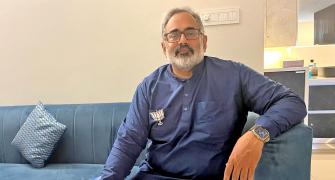Favouring corporatisation of ports, liberalised foreign direct investment in air services and creation of a Railway Development Fund, the CII on Wednesday said a growth of 7-8 per cent in the next 10 years would double the country's GDP.
According to the pre-budget memorandum of the Confederation of Indian Industry, submitted to the ministry of finance, India can achieve a 7 to 8 per cent a year growth in GDP over the next ten years to double GDP.
In this backdrop, the essence of CII's recommendations for the budget are woven around four challenges, namely:
-
The challenge of building world-class infrastructure;
-
The challenge of improving agricultural growth;
-
The challenge of empowering youth and creating adequate employment opportunities; and
-
The challenge of continuously enhancing the competitiveness of Indian companies.
CII has made detailed recommendations to the government for increasing investments in the infrastructure sector. Key amongst these are:
- Making the construction and concreting of village roads a major priority for 2004-05 by setting clear targets and financing plans monitored as well as the NHAI programme
- 15% additional depreciation should be given on plant and machinery for capacity growth of 10% or more. This provision is currently available for additional capacity of 25% or more. CII also recommends that this facility should extend to the construction industry for any capital expenditure that enhances gross block by 10% in any given year.
- Rural Housing needs to be given a boost. Rural housing loans of banks as well as housing finance companies should be counted as a part of the priority sector loans and advances. Also the rural housing portfolio of banks and housing finance companies should be accorded infrastructure status under a variation of Sections 80IA and 80IB of the Income Tax Act.
-
Provident and pension funds are traditionally long-term investors. Housing finance companies are the only lenders who carry loan assets for periods of 15 to 20 years. Hence, bonds/deposits of housing finance companies with a credit rating of "AAA" should be made an eligible form of investment by provident and pension funds.
-
In Railways, the key recommendations are -- levying a 5% across-the-board cess on passenger fares to create a Railway Development Fund (The government should give a matching grant) and creating an independent Railways Tariff Regulatory Authority.
-
In ports CII's key recommendations are -- establishing an independent regulatory authority for ports and hastening the implementation of the corporatisation of ports.
-
In civil aviation CII has recommended liberalisation of FDI in air transport services and rationalisation of aviation turbine fuel prices.
-
In power CII has recommended that fiscal reforms in the power sector need to be encouraged. In order to achieve this there was a need to implement all the key recommendations in the N K Singh Committee Report.
CII's pre-Budget memorandum also recognises that for the Indian economy to sustain a 7 per cent plus growth rate over the next decade, the agricultural sector needs to increase its growth rate from the current trend rate of 3 per cent.
CII has made the following recommendations for enhancing growth in the agricultural sector:
-
The current APMC Act of most states prohibits transactions outside the mandi system. Even states that allow transactions outside the mandi mandate that while procurement may be direct, companies will have to pay a mandi tax. Budget 2004-05 should set up a fund that gives an incentive to those state governments that amend the APMC Act in line with the model APMC Act.
- Current efforts of government in extension work should be substantially supplemented by the private sector. To encourage the private sector to invest in agricultural extension activity, the weighted income tax deduction available to investments in R&D under Section 35(2AB) should be extended to investments made in extension work.
- Larger amounts of private investments should be mobilised for water management, storage, transportation, information technology, post-harvest mechanisation, etc., to supplement government investment. To encourage this, such investments should qualify for exemption from tax of profits similar to the investments in infrastructure under Section 80(IA).
- Likewise, corporate sector investments in rural irrigation should also be eligible as investment in infrastructure under Section 80(IA).
-
Private companies should be allowed to invest in wasteland development, so that they can plant trees for their own requirements on a sustainable basis.
Given that the tax system, under which the Indian industry operates, plays an important role in determining the industry's competitiveness, CII's recommendations on direct and indirect taxation aim to provide a structure that is conducive to growth and innovation in the industry.
In direct taxation the main recommendations made by CII are:
- Reduce corporate tax rate from 35% to 30% and remove the surcharge of 2.5%
- Withdraw dividend distribution tax
- 15% additional depreciation for increasing capacity by 10% or more
- Extend 150% weighted R&D deduction to all sectors
- Extend time limit for availing 150% weighted R&D deduction
- 100% depreciation on energy saving and water conservation devices
- Abolish MAT for all companies
- Amalgamation and utilisation of unabsorbed depreciation and business losses
-
Reintroduce investment allowance to allow 25% deduction on investment in plant and machinery
In indirect taxation the key recommendations made by CII are:
- Peak customs duty was reduced from 25% to 20% in January 2004; continue with this rate of 20% in 2004-05 without any further reduction.
- Reduce duty by 5 to 10 percentage points on raw materials, intermediates and components wherever possible so that the duty on these is at least 5 percent lower than the finished products.
- Remove all remaining anomalies where customs duty on inputs is more than that on the finished product. Anomalies should also be removed in cases where the finished product is on a list of items given preferential access under a free trade agreement.
- In general, scrap 0 per cent customs duties except for life saving drugs and security related items, and those agreed to through multilateral or bilateral agreements. This includes the import of capital goods under zero percent category for project imports and others.
- Where project imports are allowed at 5 percent duty, extend deemed export benefits to domestic producers.
- Allow major inputs for capital goods to be imported at 5 percent lower rate of duty than the duty applicable on capital goods.
- Other than exceptions (e.g. certain agricultural products or automobiles), have only four tariff lines: 5 percent, 10 per cent, 15 per cent and 20 per cent. This may be rationalised to a three-tier structure in 2005-06: 5 per cent, 10 per cent and 15 per cent.
Implementation of VAT: The postponing of state-level uniform VAT in 2003 has been a major setback for fiscal reforms and competitiveness. Budget 2004-05 must clearly state the target date by which VAT will come into being, and the date should not be beyond April 1, 2005.
Credits on service tax against excise: Companies must be allowed to MODVAT the various service taxes, which cascade on to the price of the finished good/service. This should be two-ways: service tax credit against excise, and excise credit against service taxes
Central Sales Tax should be reduced from 4 per cent to 2 per cent
Remove SED of 8 per cent on selected good: Given this year's revenue buoyancy and expectations of future growth, the SED of 8 per cent on tyres, aerated soft drinks, polyester filament yarn, air conditioners and certain categories of motor vehicles should be removed, and excise duty should be brought to the CENVAT rate of 16 per cent.
Cement: The specific excise duty on cement and cement clinker were both increased in Budget 2003-04 to Rs. 400 per ton. Cement being a basic good, crucial for construction and for generating employment, the government should bring the specific duty down to Rs 350 per ton.
National Calamity Contingent Duty: 1 per cent duty was imposed in Budget 2003-04 on PFY, motor cars, MUVs, two-wheelers and Rs 50 per ton on crude oil as NCCD, for a period of one year. It has been extended by another year in the interim budget 2004-05. This should be withdrawn in Union Budget 2004-05.
Kelkar Committee recommendation of 14 per cent general rate of excise duty: CII believes that given the present buoyant economic regime, this is the right time to implement this recommendation, and reduce the CENVAT rate of 16 per cent to 14 per cent. If so, all previous recommendations regarding 16 per cent should be read as 14 per cent.
On the important challenge of educating and empowering the Indian youth, CII has recommended that the following measures be introduced in the Union Budget 2004-05:
- Reduce customs duty on computers and peripherals from 10 per cent to 5 per cent.
- Full tax-free status for 15 years to companies laying fibre optic cables, for that part of the business that connects to villages.
- Make adequate provisions for the supply of computers to Kendriya Vidyalayas and central educational entities across India.
- Provide incentive linked grants to states that undertake extensive computerisation of village schools under a new programme, called 'The School IT Project.'







